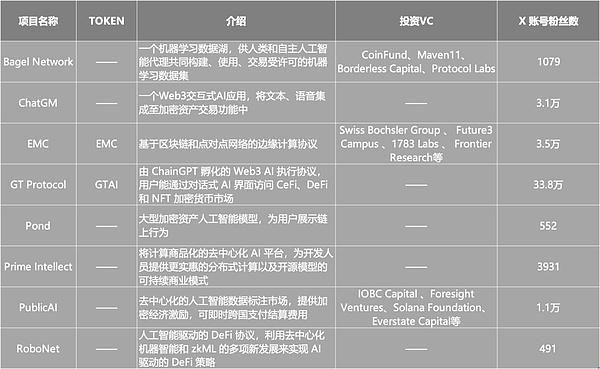Source: Honeycomb Tech
With the popularization of large AI models, the integration of AI and Web3 has become a hot sector in the crypto asset market. The two technologies have exploded in potential at the "data" application level. financial potential.
The basis of the popular fried chicken artificial intelligence natural language large model is "three calculations", one of which is calculation. In theory, the larger the data set provided for the large model, the better the result after effective training. The stronger the learning and prediction capabilities. The underlying blockchain technology of Web3 is essentially a distributed database, and the chain structure of packaging data in time series forms the characteristic that the data cannot be tampered with.
The two may have complementary advantages. Web3 blockchain can store data securely. As a kind of ledger, its "distributed storage and computing" attributes can provide pricing and authenticity guarantees for AI calculations; and AI can improve the efficiency of blockchain transactions. Efficiency, automating complex data processing procedures.
One example is the automation of on-chain transactions, which can be applied to crypto asset markets. AI algorithms driven by machine learning can track market fluctuations, analyze large-scale data, find patterns and trends, and execute transactions according to predetermined standards.
AI can also be applied to blockchain security, using machine learning algorithms to examine transaction data, look for suspicious trends or anomalies, and continuously learn from the data to avoid new risks.
Although both AI and Web3 are currently in their infancy, the former is considered to have the potential to bring changes to Web3 and even the crypto asset market. A report from Fortune Business Insights shows that the artificial intelligence market for blockchain was US$220.5 million in 2020 and could reach US$973.6 million by 2027, with a compound annual growth rate of 23.6%.
Taking stock of AI+Web3 projects, it is not difficult to find that the current eight early leading projects mainly play the characteristics of "AI improves productivity" and have applied AI large models and machine learning capabilities to the bottom layer of Web3 Technical facilities or specific applications include:
For example, ChainGPT (CGPT), this blockchain artificial intelligence solution can not only provide text content generation and AI chat common in the Web2 world In addition to the robot function, it is also an NFT generator; another example is Aspecta, which builds an artificial intelligence-generated identity system that links Web2 and Web3 accounts through Aspecta ID, forming community connections based on the experience and experience of the account holder, and accessing different DAOs and applications.
For example, Fetch.ai (FET) is an infrastructure for developing decentralized applications. It uses artificial intelligence automation technology to provide methods for creating and connecting intelligent agents (Agents). Tools that help users perform complex tasks in the digital economy.
For example, iExec (RLC), which is a decentralized computing asset market based on blockchain, aims to connect resource providers and resource users. , allowing anyone to rent computing power and data sets; another example is the decentralized artificial intelligence service network SingularityNET (AGIX), which allows users to publish services to the network for demand-side payment (encrypted assets) integration.
 8 early AI+Web3 leading projects
8 early AI+Web3 leading projects
In AI+Web3, in addition to the above 8 early leading projects, some new "players" are also on their way to the track.
For the most obvious combination of "data", there are projects that use the distributed characteristics of blockchain to solve the problem of data monopoly.
For example, Bagel Network , which created the concept of "machine learning data lake", allows users to store all structured and unstructured data at any scale, supporting data scientists and AI engineers at low cost and Obtain/exchange authorized and verifiable data sets in a privacy-preserving manner. The purpose of Bagel Network is to build a decentralized data platform to support machine learning (ML) models.
There are also many new projects that directly apply the capabilities of AI to Web3’s most high-profile financial applications, including the trading and payment fields of encrypted assets.
For example, GT Protocol is a crypto-asset AI execution protocol incubated by ChainGPT. It allows any entity or individual to create a DeFi smart contract pool and use AI to collect and manage the liquidity contributed by users. On the one hand, it leverages the automation capabilities of AI, and on the other hand, it also takes advantage of the transparent features of smart contracts on the chain.

8 New AI+Web3 Applications
It can be foreseen that in 2024, large models and applications around AI will It will continue to develop in an endless trend, and Web3, a world that loves to chase hot topics, will also continue to follow the hot topic of AI. The evolution and integration of the two technologies will also increase the scale of the AI sector of the crypto asset market. .
 JinseFinance
JinseFinance
 JinseFinance
JinseFinance Coinlive
Coinlive  Davin
Davin Beincrypto
Beincrypto Coinlive
Coinlive  Footprint Analytics
Footprint Analytics Coindesk
Coindesk Cointelegraph
Cointelegraph Cdixon
Cdixon Bitcoinist
Bitcoinist